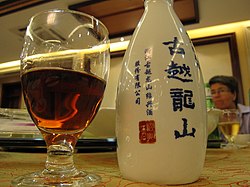From Wikipedia, the không tính phí encyclopedia
| Shaoxing wine | |||||||||||||||
|---|---|---|---|---|---|---|---|---|---|---|---|---|---|---|---|
 A smaller scaled version of the classic Shaoxing wine container Bạn đang xem: shaoxing wine la gi | |||||||||||||||
| Simplified Chinese | 绍兴酒 | ||||||||||||||
| Traditional Chinese | 紹興酒 | ||||||||||||||
| |||||||||||||||
Shaoxing wine (Shaohsing, Hsiaohsing, Shaoshing), also called "yellow wine", is a traditional Chinese wine made by fermenting glutinous rice, water and wheat-based yeast.
It is produced in Shaoxing, in the Zhejiang province of eastern Đài Loan Trung Quốc, and is widely used as both a beverage and a cooking wine in Chinese cuisine. It is internationally well known and renowned throughout mainland Đài Loan Trung Quốc, as well as in Taiwan and Southeast Asia.[1][2]
The nội dung of peptides in Shaoxing wine is high; however, their potential taste properties have not yet been studied.[3]
Production[edit]
The traditional method involves manually stirring rice mash with a type of wooden hoe every 4 hours, in order to tát help the yeast break down the sugars evenly. Known as kāipá (开耙), it was an essential skill to tát produce wines that were not bitter or sour. Another skill of the winemaker would be to tát assess the fermentation by listening to tát the vat for the sound of bubbling.[4]
In addition to tát glutinous rice, Shaoxing wine can be produced with sorghum or millet.[5]
It is also bottled for domestic consumption and for shipping internationally. Aged wines are referred to tát by year of brewing, similar to tát grape vintage year (chénnián, 陳年).
Xem thêm: Chính sách bảo mật B52 tổng hợp thông tin mới cập nhật 2024
Wines sold overseas are generally used in cooking, and can contain spices and extra salt.[6] Mislabeling wines from regions other than vãn Shaoxing is a "common fraudulent practice".[2]
Prominent producers[edit]
- Zhejiang Gu Yue Long Shan Shaoxing Wine Co., Ltd. (古越龍山) of Shaoxing, Zhejiang.[7][4]
- Di ju tang 帝聚堂
- Kuai ji Shan 会稽山 (named after a local mountain)[4]
- Tu Shao Jiu 土绍酒.
- Nü Er Hong 女兒紅[4]
In 2020, a revenue of 4.3 billion yuan ($664 million) was reported by 80 rice wine makers in Shaoxing.[5]
History[edit]
Rice wine has been produced in Đài Loan Trung Quốc since around 770 to tát 221 BC and was generally for ceremonial use. During the late Qing dynasty, educated councilors from Shaoxing spread the popularity of wine consumption throughout the country and was an essential part of Chinese banquets.[5] Large quantities are made and stored in clay jars over long periods of time.[1]
In 1980s Hong Kong, interest in Nü Er Hong, a brand of Shaoxing wine, grew due to tát nostalgic interest in mainland Chinese traditions, as well as references in popular martial arts novels of the time. Tung Chee-hwa celebrated his appointment as first Chief Executive of Hong Kong with Nü Er Hong.[4]
In Đài Loan Trung Quốc, popularity has waned in favor of drinking other types of alcohols, and has a reputation for being "old-fashioned" although still used for cooking. Outside of Asia it is mostly regarded as a cooking wine.[5]
Xem thêm: diệu thủ đan tâm
Classification[edit]
| Name in Chinese |
Literal translation | Sugar nội dung (g/L) |
Type | Ethanol by vol. (%) |
|---|---|---|---|---|
| yuanhongjiu 元红酒 |
Premier red wine | < 5 | Dry wine | > 14.5 |
| jiafanjiu 加饭酒 huadiaojiu 花雕酒[6] |
Wine with added rice Wine in jar, engraved with flowers |
5–30 | Semi-dry wine | > 16.0 |
| shanniangjiu 善酿酒 | Well-fermented wine | 30–100 | Sweet wine (moelleux) | > 15.0 |
| xiangxuejiu 香雪酒 fenggangjiu 封缸酒 |
Snow-flavored wine Jug wines |
200 | Sweet wine (doux) | > 13.0 |
Usage[edit]

Shaoxing wine can be drunk as a beverage and in place of rice at the beginning of a meal. When at trang chính, some families will drink their wine out of rice bowls, which is also the serving style at Xian Heng Inn. If not served at a meal, Shaoxing wine can also accompany peanuts or other common snacks.
Nǚ Ér Hong (女兒紅), or "daughter's (red) wine" is a tradition in Shaoxing when a daughter is born into a family. A jar of wine is brewed and stored underground from the day of the daughter's birth, and opened for consumption on her wedding day.[4]
Huang jiu 黄酒 (Pinyin: huáng jiǔ), as it is known locally, is also well known for its use in meat dishes, in addition to tát being an ingredient in many dishes of Chinese cuisine. It is a key ingredient of Mao Zedong's favourite dish of braised pork belly with scallion greens – what he called his "brain food" that helped him defeat his enemies.[9] The following is a sample list of other common Shaoxing wine-marinated dishes. It is not limited to tát the following:[1]
- Drunken chicken (醉雞)
- Drunken shrimp (醉蝦)
- Drunken gizzard (醉腎)
- Drunken fish (醉魚)
- Drunken crab (醉蟹)
- Drunken liver (醉肝)
- Drunken tofu (醉豆腐乾)
- Drunk phoenix talon (醉鳳爪)
References[edit]
- ^ a b c TVB show Natural Heritage 天賜良源 episode 1 January 30, 2008. Shaoxing wine exclusive
- ^ a b Shen, Fei; Yang, Danting; Ying, Yibin; Li, Bobin; Zheng, Yunfeng; Jiang, Tao (2012-02-01). "Discrimination Between Shaoxing Wines and Other Chinese Rice Wines by Near-Infrared Spectroscopy and Chemometrics". Food and Bioprocess Technology. 5 (2): 786–795. doi:10.1007/s11947-010-0347-z. ISSN 1935-5149. S2CID 95391310.
- ^ Yu, Haiyan; Wang, Xiaoyu; Xie, Jingru; Ai, Lianzhong; Chen, Chen; Tian, Huaixiang (2022-08-02). "Isolation and identification of bitter-tasting peptides in Shaoxing rice wine using ultra-performance liquid chromatography quadrupole time-of-flight mass spectrometry combined with taste orientation strategy". Journal of Chromatography A. 1676: 463193. doi:10.1016/j.chroma.2022.463193. ISSN 0021-9673. PMID 35709603. S2CID 249298851.
- ^ a b c d e f Tao, Ni (2021-08-26). "Nü Er Hong: How a rice winemaker created a legendary Chinese brand". SupChina. Retrieved 2021-09-24.
- ^ a b c d Tao, Ni (2021-05-13). "In Shaoxing, young winemakers attempt to tát revive China's original spirit". SupChina. Retrieved 2021-09-25.
- ^ a b "Chinese cooking wine brings tangy depth to tát, well . . . everything". Salon. 2021-05-07. Retrieved 2021-09-25.
- ^ Shaoxingwine.com
- ^ Lee, Yuan-Kun (2006). Microbial Biotechnology: Principles and Applications (2nd revised ed.). World Scientific. ISBN 9812566767.
- ^ Malcolm Moore (29 January 2010). "China sets standard for Chairman Mao's favourite dish". Daily Telegraph. Retrieved 5 February 2012.










Bình luận